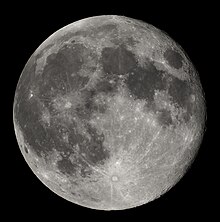Lunar mare
Mare (/ˈmɑːreɪ/;[1] plural: maria /ˈmɑːriə/) is the name for a great plain on the Moon. Several such maria exist. They were formed by ancient impacts and volcanic eruptions. Because of their high amount of iron, they reflect less light than the highlands of the Moon, causing them to appear dark to the naked eye. They are called sea Because ancient astronomers looked at the Moon and thought they saw seas and oceans, they named those dark areas maria, the Latin word for seas. The maria cover about 16% of the surface of the Moon and most of them are on the side of the moon which is visible from Earth.


A lunar mare, Mare Tranquillitatis was the landing site for the first manned landing on the Moon on July 20, 1969, at 20:18 UTC. Apollo 11 landed at 0°40′27″N 23°28′23″E / 00.67408°N 23.47297°E .[2][3]
References
change- ↑ The American Heritage Science Dictionary, 2005.
Classical pronunciations are pl. /ˈmɛəriə/ and sg. /ˈmɛəriː/. In the singular, the compromise pronunciation /ˈmɑːriː/ is commonly heard. "mare". Lexico UK Dictionary. Oxford University Press. - ↑ "Apollo 11 Landing Site". Smithsonian National Air and Space Museum. Archived from the original on December 23, 2017. Retrieved October 12, 2017.
- ↑ https://nssdc.gsfc.nasa.gov/planetary/lunar/lunar_sites.html Accessed October 12th, 2017